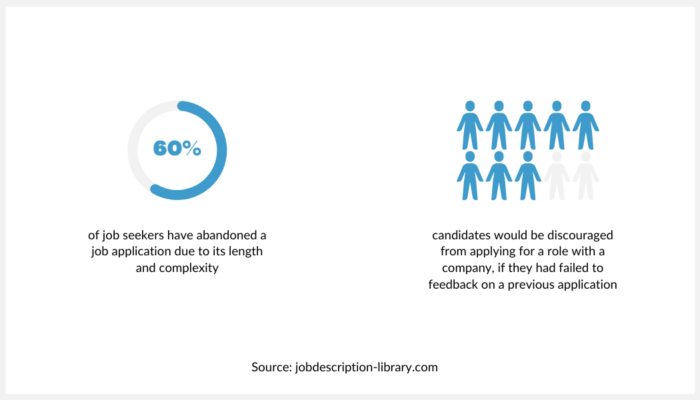
8 mistakes to avoid for the sake of the candidate experience
Have you ever wondered why you do not receive enough applications for a job advertisement, why candidates did not show up for an interview or why they abandoned the recruiting process? If you are in search and selection, these questions can lead you to question the functioning and effectiveness of your recruiting strategies. What if the cause of these situations is something else? The candidate experience can affect your ability to attract and acquire candidates. Find out which are the most common mistakes that can damage the candidate experience and how to avoid them.
SUMMARY
- What is candidate experience
- Candidate experience: the impact on the company and why it is important
- 8 mistakes that damage the candidate experience
- How to map the candidate journey successfully
What is candidate experience
The term candidate experience is generally used to refer to the entire experience of the candidate within the various stages of the recruitment process (candidate journey).
This concept refers to the actions the candidate has taken and the activities he or she has participated in, but also includes the candidate’s impressions of the company and the feelings he or she has had from the attraction phase to the onboarding phase.
The candidate experience starts even before filling out the application form for an advertisement, i.e. with the candidate’s demonstration of interest by visiting the company’s website, searching for information on the web (reviews, forums) or talking to people (employees, employee ambassadors).
Candidate experience: the impact on the company and why it is important
63% of candidates are dissatisfied with the lack of communication from companies when applying for an open position.
Interaction with candidates during the recruiting process is an aspect that can no longer be neglected. The negative effects on recruitment performance and results are obvious, as well as those of poorly organised activities, the use of inappropriate tools, etc.

It is important to avoid actions that, even if unconsciously, can have a negative impact on candidates and thus damage the candidate experience. From application forms that are too long, to the lack of feedback: certain mistakes can cost the candidate’s idea of the company, compromise its reputation, competitiveness and values.
8 mistakes that damage the candidate experience
In the digital age, it is important to be able to arouse interest in candidates as well as get positive reviews or comments online. While this is good in terms of visibility, we must remember that it is nothing definitive.
The candidate’s opinion, impressions and feelings can change quickly and be contradicted. That is why, during the candidate journey, it is important not to make mistakes that can ruin the candidate experience and, if necessary, to find immediate solutions to solve them. Let’s look at the most common ones:
1. Not using the career page for storytelling
Many companies do not have a career page and, if they do, they either do not use it to its full potential or tend to simply use it as a container for job advertisements.
In these cases, on what basis should a candidate decide to work in your company?
The Work with Us page is a manifesto, as well as a showcase, to show the world – if you can call it that – who we are, what our goals and values are. Building one with Inrecruiting not only requires no technical skills, thanks to the drag-and-drop editor, but it even helps to make your brand speak for itself in graphics and content.
2. You do not create content that meets candidates’ expectations
One of the reasons that can lead a candidate to reject a job offer is the failure to meet their expectations. This happens when the candidate does not find enough information in the industry or reads inadequate content that unintentionally fosters an illusion.
It is therefore important to provide candidates with as realistic and truthful an overview as possible of the labour market, the job sector they are approaching, the position they are applying for, etc. in order to reduce the drop-out rate. To do this, it is necessary to make the most of content on the website, newsletters, blog articles.
It is therefore crucial to create content for both active and passive candidates.
For example:
- What it means to be commercial within our company
- 3 key competences that distinguish a UX designer
- How to prepare for a project manager job interview
- Is it time to change jobs? Here are 3 signs to prove it
- 73 questions to an intern from our marketing team
Learn how to use SMS and Newsletters for recruiting
3. You use long and complex application forms
The application form can become the biggest obstacle between you and talented candidates. Building application forms that are all the same, long and complex is a mistake and can discourage active candidates from completing the registration and even more so passive ones.
Our advice is: aim for an application that takes no more than 5 minutes.
By using Inrecruiting, you can both customise your application forms and structure them according to your needs and target audience by using conditional fields and make it quicker for the candidate to fill them in. In this sense, having shorter forms is a good point, as is the possibility to fill them in with one click using the Apply with LinkedIn system or the auto-completion of the form thanks to the integration of artificial intelligence.
Learn more about auto-filling through artificial intelligence.
4. You do not track or centralise your processes
If you think that the way you manage processes and activities and coordinate with the team has no influence on the candidate experience, it is time to think again! There are situations that can generate frustration in the candidate:
For the candidate, being asked several times for the same information or being contacted by different people in the HR team for the same question can be frustrating.
- Having to enter the same data on several occasions
- Being asked several times for the same information
- Being contacted by different people in the team for the same issue
You can solve this issue by adopting a tool that, among other things, allows you to monitor the candidate’s progress on the hiring pipeline, track all the activities carried out by the candidate or the HR team and read them on a timeline, coordinate with the team and centralise all processes.
5. You do not allow the candidate to re-plan appointments
Why did the candidate not show up for the interview? The first mistake is not asking this question at all.
When organising job interviews you need to consider the needs of the candidate already at the planning stage: whether he/she is distant or has difficulties in reaching the meeting venue and therefore prefers a video interview, whether he/she is more willing to have the interview during lunch break or after working hours, especially in the case of a candidate who is still busy with another company, etc. The candidate can then be given the opportunity to schedule the interview by sharing with him/her the appointment calendar for booking a slot.

6. Do not provide feedback to candidates
Having received applications for an advert and having conducted interviews is no guarantee for a successful selection process.
Keep in touch with candidates during the candidate journey, follow them through all stages and send constant feedback, even by quick text messages. This way candidates will feel accompanied at every step and know that they are important.
7. Abandoning the candidate after recruitment
Standing by the candidate is important of course, but not only during the selection process. ‘Abandoning’ the candidate after hiring is tantamount to throwing away the trust and rapport you have built throughout the process.
If you accompanied the candidate during selection, he will expect the same after hiring so don’t let him down. Follow him/her through the onboarding process (also thanks to the integration of Inrecruiting with Zucchetti), protect the employee experience and employee engagement and don’t risk compromising his/her performance and presence in the company.
8. Don’t do periodic candidate experience surveys
More than a mistake, not scheduling periodic surveys to send to candidates to ask their opinion is a wasted opportunity.
Just think that only 25% of recruiters ask candidates for feedback on their experience through surveys!
With Inrecruiting you can administer questionnaires to candidates during the recruitment process or use email marketing tools (Sendin) to send surveys to specific groups of candidates. The information collected will help you better understand the candidate’s point of view and improve the candidate experience.
How to successfully map the candidate journey
If reading the above list of mistakes has rung a few alarm bells, then it is time to take action now to safeguard the candidate experience in your recruiting processes.
Where to start? We suggest you start by mapping the candidate journey: a map of the steps taken by candidates and their emotions/experiences during all phases of the recruitment process.

Digital Marketing presso Inrecruiting
